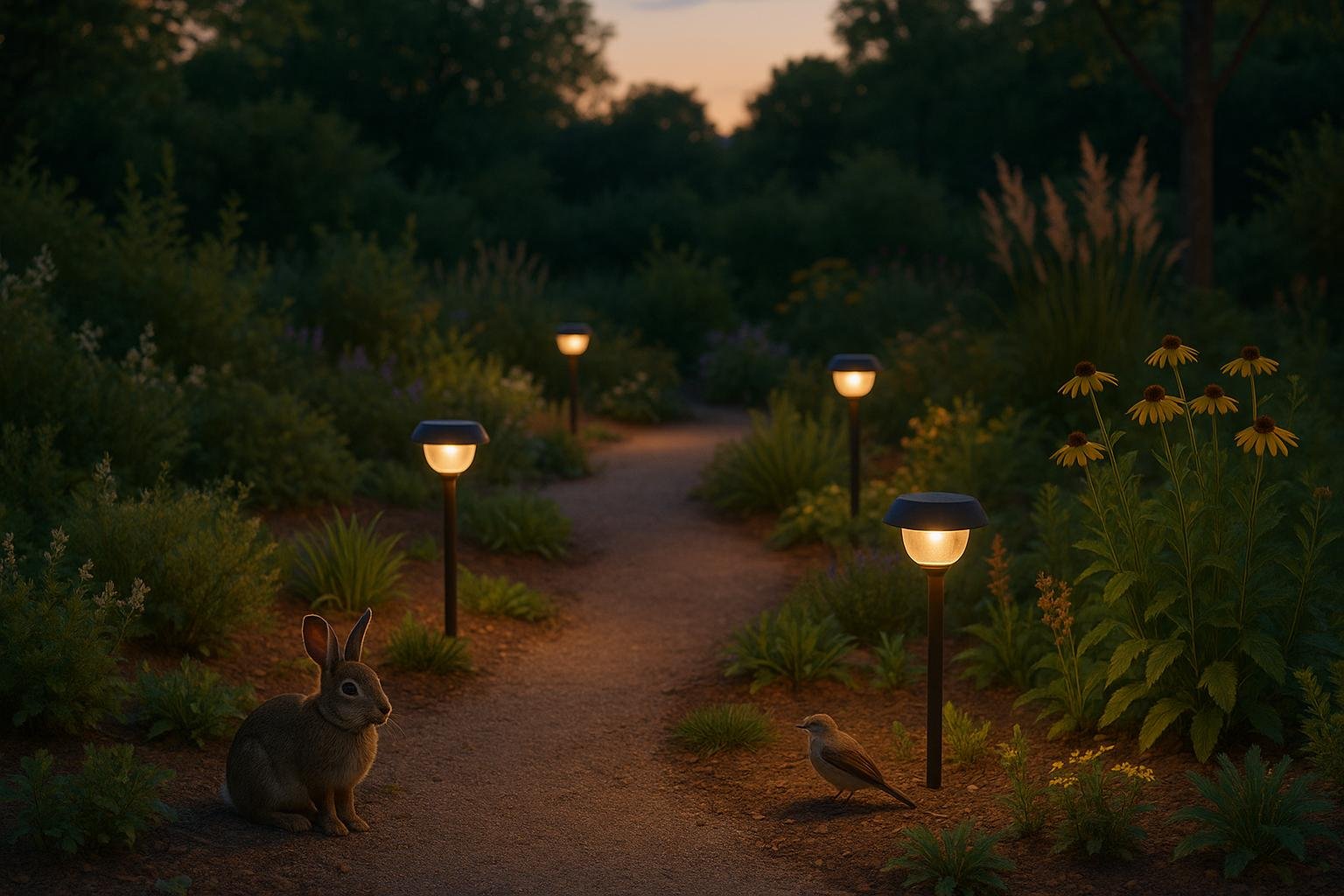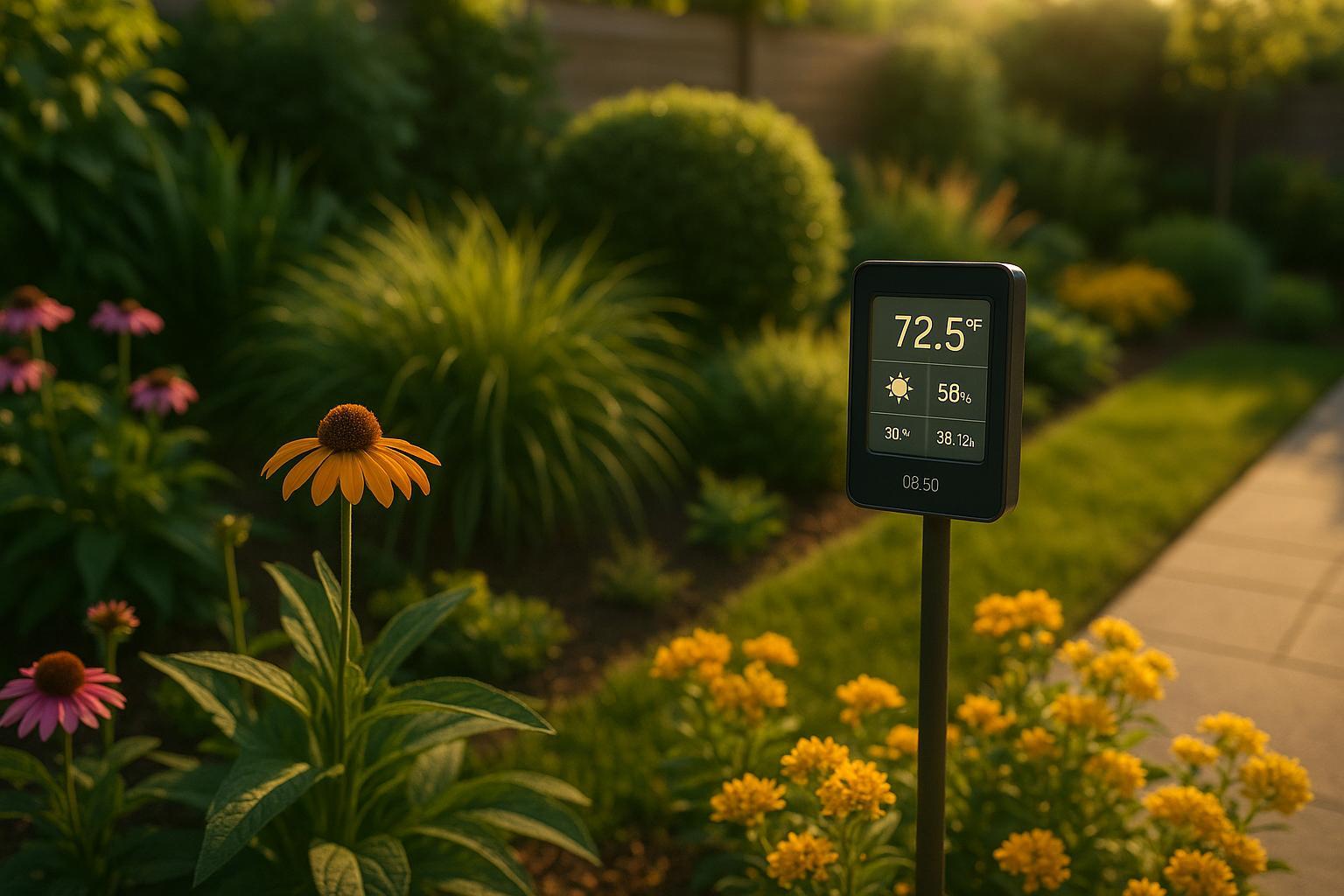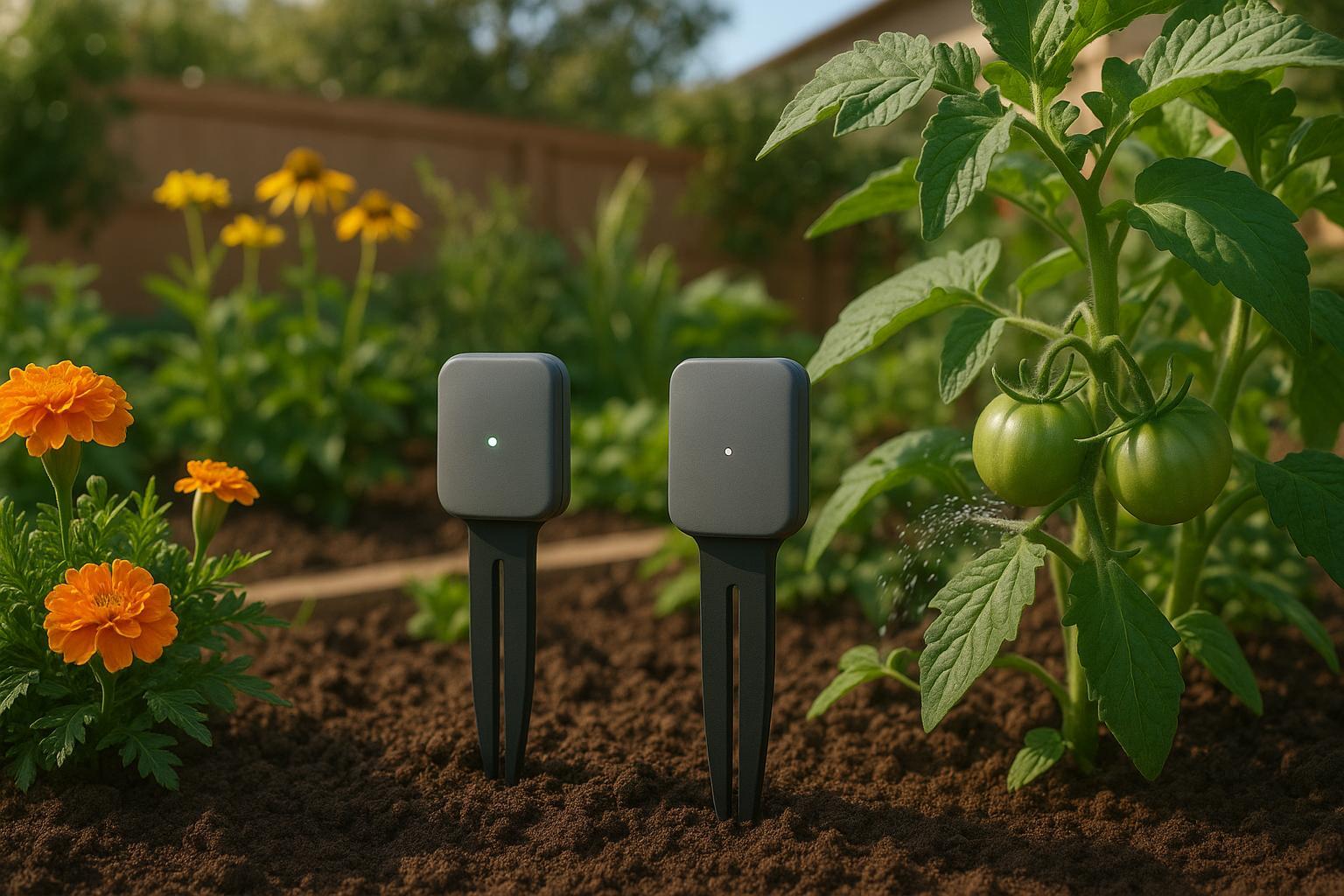Solar Lighting and Wildlife-Friendly Gardens

Solar lighting is a smart choice for creating gardens that are safer for wildlife. It reduces the negative effects of artificial light at night, which can harm pollinators, birds, bats, and other species. Proper placement, warm-spectrum lights, and controlled brightness help protect ecosystems while providing functional and attractive garden lighting. Here’s how solar lighting supports wildlife-friendly practices:
- Minimizes Light Pollution: Warm-spectrum lights (below 3,000K) and low brightness reduce disruption to nocturnal species.
- Flexible Placement: No wiring means lights can be placed strategically, leaving dark zones for wildlife.
- Smart Features: Timers and motion sensors limit light use to necessary hours, reducing impact on animals.
- Supports Pollinators: Less blue light prevents disorientation of insects like moths, helping plants thrive.
Wildlife Impacts of Artificial Light at Night (ALAN)
Artificial light at night (ALAN) doesn’t just challenge garden ecosystems - it also significantly disrupts wildlife behavior and the way ecosystems function. Research shows that increased artificial lighting throws off species that have evolved to thrive under natural light cycles. These disruptions ripple through ecosystems, altering interactions among species and even reshaping food webs.
ALAN refers to any human-made light used after dusk. Studies indicate that even minimal artificial lighting can interfere with the behavior of light-sensitive species, leading to cascading effects throughout the ecosystem.
Effects on Pollinators
Nocturnal pollinators, like moths, are crucial for nighttime pollination but are especially vulnerable to artificial lighting. Moths, which rely on celestial cues for navigation, often become disoriented by bright lights. Instead of feeding or mating, they circle artificial light sources, reducing their ability to reproduce and thrive.
This disruption doesn’t just affect the moths themselves - it also impacts night-blooming plants like evening primrose, moonflower, and night-blooming cereus, which depend on nocturnal pollinators. In areas with heavy artificial lighting, these plants may produce fewer seeds due to reduced pollination. Additionally, certain beetles that play a role in pollinating various flowering plants may become less active under artificial light, further diminishing pollination rates and genetic diversity. These changes in pollinator behavior set the stage for broader ecological imbalances.
Impacts on Bats, Birds, and Amphibians
The effects of artificial lighting on bats are complex. While some insect-eating bats may be drawn to light-rich areas teeming with insects, this doesn’t necessarily benefit them. Prey can become disoriented, making it harder for bats to hunt efficiently. Additionally, light pollution can fragment bat habitats by discouraging flight along naturally dark corridors. Urban bats often have to travel longer distances to find feeding grounds, which increases energy demands and can negatively impact reproduction.
Migratory birds also face significant challenges. Bright nighttime lighting can throw them off course, causing them to circle light sources instead of continuing on their intended paths. This disorientation has been linked to a high number of bird deaths during migration. Even non-migratory, resident birds aren’t spared - artificial light can alter their daily routines, leading to earlier dawn singing, extended evening activity, and disrupted rest cycles. These changes can increase stress levels and reduce breeding success.
Amphibians, such as frogs and salamanders, are particularly sensitive to light pollution due to their moisture-dependent lifecycles and permeable skin. Darkness is critical for their safe movement between breeding ponds and terrestrial habitats. In illuminated areas, these amphibians often become less active, limiting their ability to breed and exchange genetic material. Changes in light cycles can also shift breeding times, creating mismatches between optimal conditions and food availability for their developing larvae.
Together, these disruptions contribute to what researchers call "ecological light pollution syndrome" - a shift in ecosystems that favors species tolerant of artificial light while disadvantaging those adapted to natural darkness. Addressing these impacts can help balance the need for outdoor lighting with the preservation of wildlife and ecosystems.
Lighting Design Considerations for Wildlife Protection
Protecting wildlife while designing garden lighting requires thoughtful planning and an understanding of how artificial light at night (ALAN) affects ecosystems. By following research-backed strategies, you can create lighting solutions that minimize ecological disruption and align with wildlife-friendly practices.
Choosing the Right Light Spectrum
Studies have found that certain types of artificial light at night can increase the visibility of nocturnal pollinators to predators, putting them at greater risk [1]. Opting for lighting with a spectrum less disruptive to wildlife can help reduce this risk and support the natural behaviors of nocturnal species.
Controlling Brightness and Intensity
Field-testing is essential to determine the appropriate brightness and intensity for your space. By using practical mockups, you can identify what constitutes low-level, focused lighting that illuminates only where it’s needed, reducing unnecessary exposure for wildlife.
How Solar Lighting Supports Wildlife-Friendly Gardens
Solar-powered lighting is gaining attention as a thoughtful alternative to traditional wired systems, especially for those looking to create gardens that coexist harmoniously with local wildlife. These lights not only provide illumination but also offer features that help reduce ecological disturbances.
Smart Controls for Reduced Impact
One of the key benefits of solar lighting is its built-in timers and motion sensors, which help limit the time lights are active [4][5]. By reducing the hours of operation, these features lessen the disruption to nocturnal animals and pollinators. Additionally, solar lights often operate at lower brightness levels and naturally dim or lose power during the darkest hours, further minimizing their effect on wildlife [4].
Easy Placement to Protect Habitats
Since solar lights don’t rely on complex wiring, they can be installed almost anywhere [3]. This flexibility allows gardeners to strategically place lights while leaving certain areas untouched, creating dark zones that serve as safe spaces for wildlife [2]. With options like path lights and spotlights, solar lighting can meet specific needs without compromising sensitive habitats [2][3]. This adaptability ensures that essential dark zones remain undisturbed, supporting the garden’s ecological balance.
Designed with Wildlife in Mind
Experts often highlight solar-powered lighting as a wildlife-conscious choice for gardens [4][5]. Many of these systems use low-Kelvin LEDs, emitting warm-colored light (below 3,000 Kelvin), which is less disruptive to animals. When paired with dimmer outputs and strategic placement, these lights align with research-backed recommendations for minimizing harm to wildlife. Together, these features make solar lighting an excellent option for eco-friendly garden illumination.
sbb-itb-4d6a8dd
🚀 Ready to Reinvent Your Garden?
Join thousands of homeowners who have transformed their gardens using our AI design tool. Upload one photo to explore endless possibilities.
Get your AI garden designs →Research-Based Best Practices for Wildlife-Friendly Solar Lighting
Designing a garden that balances human enjoyment with wildlife protection calls for thoughtful lighting choices grounded in ecological research. These evidence-based practices show how well-planned solar lighting can minimize its impact on local wildlife while still enhancing the beauty and functionality of outdoor spaces.
Use Warm Spectrum Lighting
Lighting with a warm spectrum - specifically below 3,000K - is less disruptive to nocturnal animals compared to blue-rich lighting. Amber and warm white LEDs, for instance, emit fewer blue wavelengths, which are known to attract insects and interfere with their natural behaviors. When choosing solar lights, look for options labeled "warm white" or with color temperatures between 2,200K and 3,000K. These warmer tones not only provide sufficient illumination for nighttime activities but also reduce the attraction of moths, beetles, and other essential insects.
Many modern solar lights come equipped with amber filters or warm LED chips to further limit blue light emissions. This ensures that gardeners can enjoy functional lighting without causing unnecessary disruptions to the local ecosystem.
Minimize Brightness and Light Spill
Excessively bright lighting can disturb wildlife, making it important to focus on targeted illumination rather than widespread brightness. Wildlife-friendly solar lighting often incorporates lower lumen outputs and directional shields to focus light where it’s needed, such as pathways or specific garden areas. Shielded fixtures help reduce sky glow and lessen the impact on flying animals by directing light downward. Look for solar lights with features like hoods, baffles, or directional designs that concentrate illumination without spilling into surrounding areas.
Avoid using bright spotlights on trees, water features, or native plants where nocturnal animals may feed or rest. Instead, opt for low-intensity path lights or bollard-style fixtures that provide subtle, localized lighting. This approach creates gentle pools of light separated by darker areas, preserving essential corridors for wildlife movement. Pairing brightness control with precise timing can further limit the impact of lighting on nocturnal habitats.
Program Lights for Limited Hours
Limiting the operational hours of solar lights is another effective way to protect nocturnal wildlife. Solar lights with programmable timers can be set to operate during peak evening hours, such as 6:00–10:00 PM, and may include motion sensors to reduce unnecessary late-night activation. This approach aligns lighting use with seasonal wildlife activity, ensuring minimal disruption.
Seasonal adjustments to lighting schedules can also make a big difference. For example, during spring and summer - when pollinator activity is at its highest - restricting lighting hours can help maintain a healthy ecosystem. Advanced solar systems even offer calendar-based programming, which automatically adjusts lighting schedules to align with natural cycles, making it easier to support wildlife-friendly practices year-round.
Creating Balance Between Garden Beauty and Wildlife Preservation
Using wildlife-friendly solar lighting shows that gardeners don’t have to choose between a stunning garden and protecting local wildlife. The secret lies in planning with both beauty and ecological impact in mind right from the start. This approach ties in perfectly with earlier suggestions about minimizing light exposure to safeguard local fauna.
Solar lighting allows gardeners to be precise. You can highlight features like water fountains or seating areas without disturbing critical habitats like feeding or nesting zones. It’s all about thoughtful placement.
Programmable solar systems take it a step further by offering flexible lighting schedules. For example, you can have bright lights for evening gatherings and then set them to dim or turn off completely after 10:00 PM, preserving the darkness that nocturnal animals need. Motion-activated lights add even more control - providing security and illumination only when people are present, while keeping disturbances to wildlife at a minimum.
Seasonal adjustments also play a big role. In spring, you might limit lighting to protect emerging pollinators, while in winter, you could extend the lighting hours as necessary. Solar systems with calendar-based programming make these transitions effortless, switching between wildlife-conscious and human-friendly settings automatically.
Warm-spectrum lights are another great choice. They not only enhance the garden's atmosphere but also reduce light pollution. Directional fixtures that focus light where it’s needed - without spilling into unnecessary areas - create beautiful shadow effects and highlight specific garden elements far better than broad, flood-style lighting.
Pairing wildlife-friendly lighting with native plants makes your garden even more resilient. By aligning lighting zones with pollinator habitats, you create a design that supports both ecological health and visual appeal.
Ultimately, the key to balancing garden beauty with wildlife protection is seeing lighting as part of a larger ecosystem. When solar lighting is thoughtfully combined with native plants, water features, and natural wildlife corridors, you end up with a garden that’s not only visually stunning but also ecologically rich - offering benefits far beyond traditional designs.
FAQs
How does solar lighting benefit nocturnal pollinators like moths and reduce light pollution in gardens?
Solar lighting offers a surprising benefit for nocturnal pollinators like moths by cutting down on light pollution that can interfere with their natural activities. Traditional outdoor lights often produce bright, widespread beams that can confuse moths, pulling them away from their habitats and food sources. On the other hand, solar lights are designed with softer, more focused illumination, which helps reduce this disorientation and allows these essential pollinators to thrive.
Opting for solar-powered lights not only makes your garden more welcoming to wildlife but also helps maintain the delicate balance of local ecosystems. This eco-friendly lighting choice supports nocturnal insects while keeping your outdoor space both functional and visually appealing.
How can I place solar lights in my garden to protect wildlife while still providing illumination?
To make your garden inviting for wildlife, it's important to be mindful of how you use solar lights. Place them carefully to avoid unnecessary disruption. Choose shielded, downward-facing lights that sit low to the ground - this helps reduce light spilling into unintended areas. Go for warm-colored bulbs with a color temperature under 3,000 Kelvin, as these are gentler on nocturnal animals and insects. Additionally, leave parts of your garden unlit to create natural dark zones, which are vital for supporting local wildlife. This way, you can enjoy a beautifully lit garden while ensuring it remains a welcoming space for nature.
Can solar garden lights be adjusted to support local wildlife throughout the year?
Yes, you can adjust solar garden lights throughout the year to better align with the natural patterns of local wildlife. Studies indicate that artificial lighting, even solar-powered options, can disrupt wildlife behaviors like migration, feeding, and reproduction. By dimming the lights, shortening their duration, or switching them off during critical periods - such as mating or migration seasons - you can help lessen these disruptions.
These adjustments not only promote healthier ecosystems but also strike a balance between your garden's aesthetic appeal and its role as a haven for wildlife. Simple steps, like opting for warmer light tones or angling lights downward with shields, can further reduce their impact on nocturnal animals and pollinators.
Related posts
Related Articles

Solving Temperature Fluctuations with AI Tools
Explore how AI tools are revolutionizing garden management by monitoring temperatures, predicting weather, and optimizing plant care for better yields.

Smart Soil Sensors with Home Assistant
Utilize smart soil sensors with Home Assistant to automate garden watering, enhancing plant health while conserving water efficiently.

How AI Improves Companion Planting Layouts
AI transforms garden planning by optimizing companion planting through smart pairings, space-efficient layouts, and tailored care instructions.

AI Tools for Soil Health Monitoring
AI tools revolutionize soil health monitoring, offering real-time data and insights to enhance gardening and farming practices.

DIY Guide: How to Make a Garden Flag for Your Outdoor Space
Learn how to make a garden flag with this step-by-step guide. Add some personality to your outdoor space with a personalized garden flag.

Top 7 AI Garden Styles for Any Space
Explore seven distinct AI-driven garden styles, from modern minimalism to lush edible landscapes, tailored to fit any space and climate.